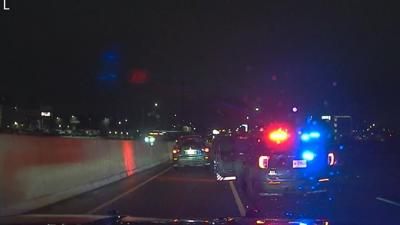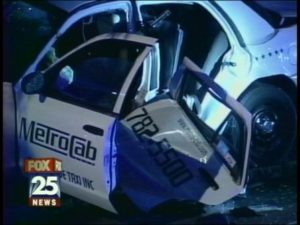But Hoyt was in Massachusetts General Hospital in Boston, recovering from a severe crash in Somerville, Massachusetts that left her in a coma.
Perhaps mercifully, she still, 11 years later, has no recollection of that early morning crash on May 27, 2007.
“It’s like I was looking at a movie,” Hoyt said. “That wasn’t my cab. That wasn’t me.”
She also didn’t remember the man in the cab with her. Paul Farris, her 23-year-old boyfriend, died in the crash, along with the cab driver, Walid Chahine.
Hoyt, and Farris’ father, Jon, later found out that a man driving without a license fleeing police had crashed into their cab.
Mashpee Police are still investigating last month’s deadly crash that killed a new father on his way home from the hospital. He was hit by a man being chased by police for driving erratically.
VIDEO 2, https://www.nbcboston.com/on-air/as-seen-on/DIT-CAR-CHASE-5—Copy_NECN-490487621.html?t=1
WATCH: Wild Police Chases From Around the Country
We are constantly seeing examples of police pursuing suspects in vehicles. Many of these pursuits are unavoidable, but there is an inherent risk to the public as vehicles weave through neighborhoods or reach speeds of more than 100 mph on highways. Here’s a look at some notable police chases from around the country.
(Published Friday, Aug. 10, 2018)
The Mashpee crash opened old wounds for families like the Farrises and the Hoyts. Victims of crashes that result from police pursuits, their families, and police themselves say that a lack of training, funding and scrutiny of pursuits is putting everyone at risk.
According to the State Police report of Farris’ crash, Trooper Joseph Kalil spotted a black Mercury SUV make an illegal U-turn on Route 16 in Everett. Kalil flipped on his lights and tried to pull over the driver, but he took off.
Kalil chased, following the SUV into the densely populated residential streets in Medford and Somerville.
The driver, Javier Morales, turned off College Avenue onto Kidder Avenue, where he crashed into the cab carrying Farris and Hoyt at the intersection with Highland Road.
“There should be no reason to have a chase here,” Hoyt said, revisiting the intersection this month with a reporter. “It just blows your mind.”
Jon Farris agrees.
“If I had been told that they were pursuing someone who shot somebody, had raped somebody, truly a violent felon, Paul would still be dead. I would still be heartbroken. But I would understand that,” Farris said. “The fact that a guy made an illegal U-turn and then ran from police, ultimately we found out that he just didn’t have a driver’s license. He was running because he was afraid he was going to go to jail, which he would have. But that made no sense to me. And so Paul’s dead and in my mind, there’s zero reason.”
Jon Farris lost his son Paul in 2007. Massachusetts State Police changed their pursuit policy shortly after the crash.
(Published Thursday, Aug. 9, 2018)
Every deadly pursuit feels like a knife in the heart, Farris said. For the last decade he has pushed for more national oversight and accountability into what he calls an underreported public threat.
“No one has a clue how bad this is,” he said.
On average, nearly one person is killed each day in pursuits across the country, according to the U.S. Department of Justice.
In Massachusetts, 225 people have been killed since 1982. Thirty percent were innocent bystanders like Farris and Chahine.
Mashpee police are continuing to investigate a crash that killed three people last month. Police pursued an erratic driver who failed to stop. He ended up crashing head on into an SUV driven by a new father on his way home from the hospital. That crash has stirred difficult memories for victims and families of other police pursuit crashes. They tel…Read more
(Published Thursday, Aug. 9, 2018)
Fred Leland, a retired Walpole police lieutenant who trains police in pursuit conduct, said cops “live in the gray” of unknowns and potential danger when deciding in the heat of the moment whether to pursue a driver speeding away.
“What if I say, ‘You know what it’s not that serious I’m gonna let him go,’ and then he goes down the street and hits somebody anyway?” he said.
Despite the media spotlight on dramatic pursuits, like one a month ago in Las Vegas where an officer returned fire through his own windshield at a fleeing vehicle he knew held dangerous felons, most attempted stops are more mundane.
According to the Department of Justice, two-thirds of pursuits begin, like the crashes in Somerville and Mashpee, with a traffic violation: speeding, erratic driving or a suspended license.
And for police, the chase itself is often a trial by fire. Leland said local departments do not get enough training, and real-world pursuits are not common for a given officer.
“We don’t have much experience in pursuits,” Leland said. “I know we’re the police and you see them on television and you think, ‘Oh you do them all the time.’ But no, we don’t.”
Officers get 48 hours of driving training when they first join the police academy. Pursuits are part of it, but what happens after that depends on their department.
“Some places do more, some places do less,” said Steve Wojnar, chief of the Dudley Police Department and president of the Massachusetts Chiefs of Police Association.
He said all departments have written pursuit policies, but like the situations officers face, none are the same. And he agreed that training officers in pursuits should be mandatory.
“You never know exactly what it’s going to be like. You’re going to constantly reassess and re-evaluate the situation,” he said. “How are you going to function under a stressful situation? Are you going to be able to react? Are you going to be able to react properly?
But, as always, the obstacle for cash-strapped departments is paying for it.
“Training is the last thing to be funded and the first thing to be cut when there’s problems and that’s bad,” Leland said.
Bad, too, for a father who lost a son over an illegal U-turn.
“I don’t want other people to have to go through it. I shouldn’t have to be crying every other day when I’m mowing the lawn. It’s horrible,” Farris said.
Farris has been pushing federal legislation that would require departments to track pursuits and would fund more training. He also favors policies that would restrict when officers can pursue to when the officer knows he is chasing a violent felon.
Wojnar hopes training money could also come from the local police training bill Gov. Charlie Baker signed last week.































